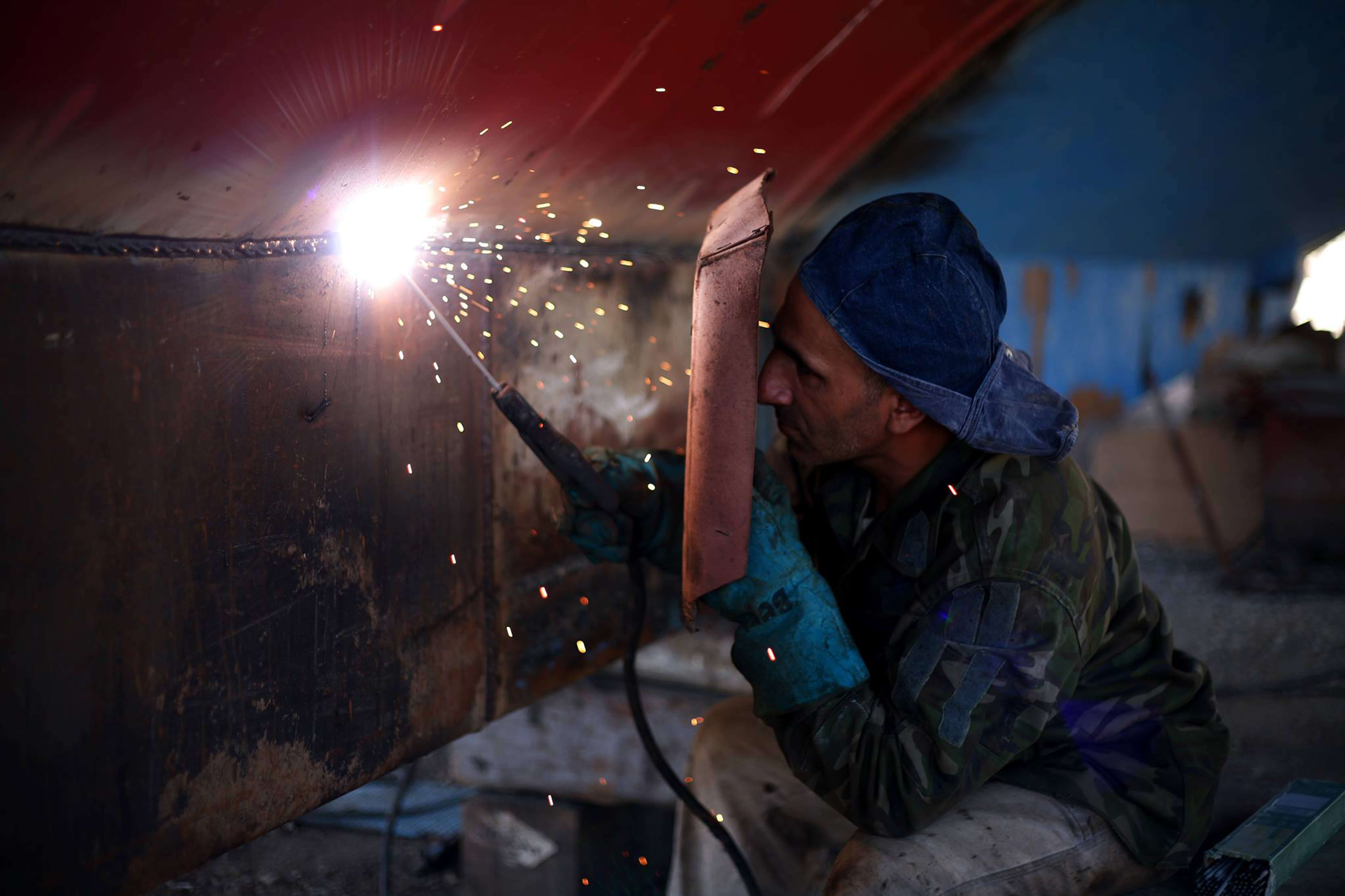By Talmage Ekanger
“The difference between an amateur weld and a professional weld is a 6-amp grinder!” Jake said as he started to “correct” a sloppy weld. Jake didn’t have any formal training; he just knew the basics of welding, and I didn’t.
Whenever I needed metal stuck together, he was more than happy to help me for the sheer pleasure of watching the sparks fly. Thanks to his price, for years Jake was my go-to guy for welding. Maybe the quality may not have been top notch, and a grinder was required afterward to make the weld visually pleasing … but at least nothing fell apart.
Fast forward 20 years.
I now have a welder of my own and thoroughly enjoy sticking metal together every bit as much as Jake did. I also lack formal training, but I did recently learn that Jake’s statement was all true– just not for the reasons he thought. Here are the basics of welding — what all amateurs should know.
The Basics of Welding
Start with a Clean Surface
Welding is a lot like painting, results are dictated driven by preparation. In order to get a good weld, the surface must be free of oil and debris.
An angle grinder provides this by removing the outside layer of oil, paint or other contaminant and exposing the nice clean steel underneath. Particularly when welding with light-duty welders on thicker steel, penetration can be greatly enhanced by preparing the weld with a V-groove between the pieces of steel being welded … another great use for an angle grinder. In both cases, the angle-grinder can be the difference between an amateur or professional weld.
Steel Prep
Whether a DIY project is created from new steel or old, all steel needs to be prepped before welding. I’ve probably welded as much or more on used steel than new steel. Fixing broken items almost always includes welding to previously finished and used steel.
In addition, I build a lot of projects out of reclaimed steel (old bed frames are a favorite source of steel for me). Either way, used steel is usually painted to prevent rust, unless the bare steel has become a rusted relic itself, and all paint and rust should be removed before welding.
Avoid Welding Through Paint
Welding through paint seems like it should be possible. It would seem that the high temperature of welding should make quick work of burning away the paint, allowing the weld to take hold. However, the fumes and chemicals released in the process of welding painted metal not only harm the welder but are toxic to the weld itself.
The released gasses and chemicals mix with the metal, compromising the strength of the weld. It may hold for a while, but it won’t last forever. For a good weld, all paint should be removed within one-quarter inch of the weld site.
Tips for Rust
If reclaimed metal is not painted, it is likely rusty. Welding to rusty metal is both ineffective and miserable in its own way. Rust, also known as iron oxide or FE2O3, is an excellent preventer of welds, the primary reason being chemistry.
When iron oxide is heated, it releases one of its extra oxygen atoms to react with something else. When welding, that something else is the steel you may be attempting to weld, and the result is that the metal will get burned rather than melted and welded. In addition, the air pockets that develop in heavily-rusted metal also provide a certain amount of insulation against good weld penetration. In either case, welds across rusty metal tend to not hold well.
Still, rusty metal provides a better incentive to prep before welding. Iron oxide, while cancerous on trucks, does have its uses. It is a key colorant in some paints, and it is also an excellent catalyst used in Thermite. Thermite, a mixture of iron oxide and aluminum powder, is a military grade incendiary substance used for breaching armor plating. In the domestic world, thermite can be used for welding … if you are trying to weld two railroad ties end to end. The heat generated is absolutely phenomenal and barely controllable.
It is probably no surprise that rust doesn’t weld well. To the contrary, welding to rusty metal looks a great deal like fireworks (another domestic item in which rust is an ingredient), blasting molten sparks in every direction at a rate exponentially greater than standard welding. While impossible to prove, the sparks that appear to travel at random, actually have a unique homing ability to locate the one path down my collar or into my boot and up against my skin, where they brand me as a speckle-belly. Typically, this results in new and unconventional dance techniques usually only seen in a garage. While I suspect welding was involved in the development of both disco and break dancing, as with those trends, eventually the novelty of being branded wears off, and I’ve learned to prep the metal first.
New Steel
New steel is much more fun to work with. It looks nice, with an even dull grey-black oily finish that’s consistent and even over the whole surface. It makes a much nicer raw material for a DIY project than reclaimed steel. However, that dull-grey finish is not the color of steel. It is paint of a sort, applied as a rust preventative. While the coating is generally thin, it offers the same problems with welds that other types of paint does. Therefore, for a good weld, the paint should be removed with a grinder before welding.
These basics of welding should help most beginners (and those that need a refresher course). At the end of the day, my buddy was right, the difference between a professional and an amateur weld is a 6 amp grinder … and the pros will use it first!
Talmage Ekanger is a husband, father of three, writer, and attorney-turned-information-technology-supervisor. A native South Dakotan, he’s grateful for the chance to raise his family in the land of the free and the home of the brave.







These are a lot of good tips. As a self-taught welder, I would have benefited from these and more as I got started.
* What type of welder? I chose a wire-feed and I’m not sorry.
* How do you get your wire to feed better? Looser spool tension was my secret.
* How quickly do you move your welder across the welding area? A lot more slowly that I anticipated!
I got a lot of help from the Chucke2009 YouTube channel and a few answers from friends who farm and therefore weld.
Reply from the author, Talmage Ekanger:
* What type of welder do you use?
I have a small wire-feed, which was a good place to start. First, it was on a great sale and didn’t cost me a lot. The only things I really demanded were 1. The ability to use either gas or flux core MIG, 2. Power to the wire controlled by the trigger pull (not just feed…the really cheap ones leave the power on all the time–That’s a pain). In retrospect, I would have purchased the Hobart equivalent of the one I did buy, because an aluminum spool gun would be a possibility then, but what I did was a great place to start.
I currently have some power issues in my garage, so I’m stuck with 120 volt until I get that sorted. I’m hoping to move on to TIG in the near future, but by all accounts I’ve heard Tig is a new learning experience all together. It’s also slower, so even when I have TIG available, I’ll keep my wire feed MIG for when I’m in a hurry.
I have the ability to use gas or flux core. However, I lean toward flux core. I have two problems with gas: 1. I’m not smart enough to close the tank after I finish, and even though the welder shuts it off when I’m not welding, there is a slow bleed and I’m tired of paying for gas I’m not really using. 2. For reasons I can’t explain, it seems like I get better results with lower power when I use flux core. I don’t know why, but since I’m power-constrained in my garage, flux core works better.
* How do you get your wire to feed better? Looser spool tension was my secret.
I haven’t had a lot of problems with feeding. Initially, I don’t think I clamped the wire tightly enough between the feed roller and the clamp roller (no idea what it should be called). Now I crank that down pretty tightly and I don’t have a lot of problems.
I did have to replace a feed motor once, but overall just trial and error on the feed spool would be all I could suggest. Lately, my speed control nob has been behaving oddly and it might need to be replaced, but I may want to hold off on fixing that until it completely fails to help justify purchasing a TIG welder with my wife….hope she didn’t read that.
* How quickly do you move your welder across the welding area?
As with so many answers….it depends. First, the thicker the metal, the slower I go. In the welding process itself, you are melting both pieces of metal and trying to get it all to mix together into one. So, you need a tiny pool of melted metal following your wire along behind the spark and both pieces should be contributing to the pool. Thicker metals have a lot of thermal mass to overcome, where thin sheets don’t. So, if I hang out for the same amount of time on a piece of 16 gauge as I do when I’m welding quarter inch….I’ll burn right through.
I no longer run my speed mechanically. I’ve grown used to watching the pool of metal and I move at a rate that keeps that pool flowing behind my wire and following my arc as I move it along. If the pool isn’t forming well and clearly mixing from both pieces of metal, I slow down. If it is or I’m burning through, then I speed up. If I can’t keep up, I turn down the power. At some point, with practice, it becomes less of a science and more of an art.
Welding metals of dissimilar thicknesses is interesting as well. When welding, I move my arc back and forth across the work pieces in little U shapes, with the U opening up in the direction I am welding. One side of the U serves to pre-heat one piece of the metal, then the other side pre-heats the other side, then when I drop back and cross between the sides, the heat is maximized and it brings my pool together. Since thicker metals take more to pre heat, I have to spend more time on the thick side of the U. The more dissimilar the thickness, the more challenging it is to make it work.